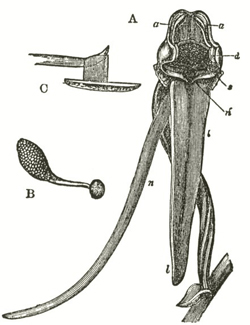The Books of Darwin
More Books continued

Large butterfly orchid, in Charles Darwin, On the fertilization of orchids, 1862
Fertilization of Orchids (1862)
When thinking of Darwin, the place of humans among other species comes first to mind. In fact, after writing On the Origin of Species, most of Darwin’s research and writing was on plants. Six of the ten books Darwin wrote after the Origin were on plants, and two of the remaining four books touched on them. The first book was On the various contrivances by which British and foreign orchids are Fertilized by insects, and on the good effects of intercrossing, published by John Murray in 1862. The book contained the detailed observations that he thought necessary to support his theory of natural selection, focusing on the complex interplay between plants and insects—a work of ecology. Moreover, this book was calculatedly clever. Orchids were among the most varied, profligate, and showy of plants. Darwin concluded that
“In my examination of Orchids, hardly any fact has so much struck me as the endless diversity of structure,—the prodigality of resources,—for gaining the very same end, namely, the fertilization of one flower by the pollen of another, . . . the fact [of which] is intelligible on the principle of natural selection.” [pp. 348–349].
If the variety and beauty of orchids—the least competitive, most benign, and most fancifully useless of creatures—was the result of natural selection, what could stand in the way of accepting natural selection where nature was “red in tooth and claw”?
Last Reviewed: May 7, 2014


